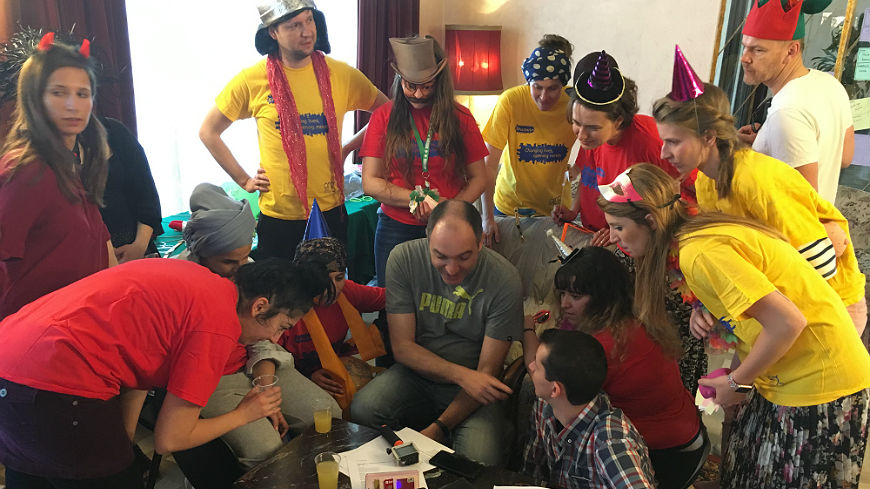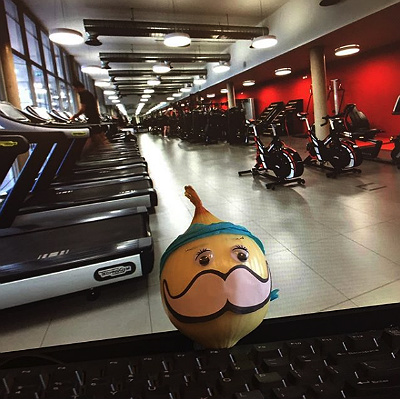Digital developments in youth work training
A practitioner’s perspective after some years of doing and training digital youth work
by Michele di Paola
15/06/2018

© All illustrations from: Dig It Up! training course
by Michele di Paola
15/06/2018
Experts are clueless
Steve Jobs
According to his close collaborators, Steve Jobs used to smile remembering that some consultants in 1984, while he was designing the Macintosh system, would advise Apple to build and sell a “daisy wheel printer”, because the market would require this device. Nowadays, most of you will never have even heard of this kind of printer, which quietly disappeared at the end of 1980s, while I am here today writing this article on a Macintosh.
When we talk about digital youth work, we are using an expression that has been created and grown (a bit) popular in the last two to three years. Honestly, it would be impossible to picture what it could go on to become in, let’s say, five years from now. Moreover, when we consider digital youth work happening inside private digital media platforms, such as Instagram nowadays, we are basically playing football in someone else’s garden, and we do not even own the ball. Players (and interests) very far from our understanding are in motion and having any clue as what they could have in store for us is just impossible.
What we could do is identify some possible trends and make ourselves ready – or even better, try to define a basic set of skills which could possibly help us in any future scenario.
So, what is actually coming?
Maybe the growth of “virtual reality” (VR) headsets and software will bring us to completely new and uncharted territories, where one could experience being in places and situations without leaving home (or the youth centre).
Or maybe the growth of e-sports will (finally!?) make video games more relevant and more widely adopted in youth work contexts, so that it will not be only me and a few friends and colleagues using them in non-formal training sessions. “Hello Professor Falken, what about a nice game of chess?” [War Games movie, 1983]
Instead it might be a makers’ culture of hacking and tinkering with devices to actually change the world into one where a sentient computer network called Skynet would employ a Schwarzenegger robot to get rid of its human opponents? “Hasta la vista baby.” [Terminator 2 movie, 1991]
Our future may resemble any of these examples, or it may be completely different. We have seen it happening already: disruptive innovation in the youth work field may really happen out of the blue and have a very deep impact in a very short time.
What should a digital youth worker do to keep up, then?
Hint: “An agile mindset is crucial”
As the EU experts’ group publication “Developing digital youth work”1 says, having an agile mindset regarding digital tools is the only way to survive a future where digital youth work will be indeed crucial, but nobody will know how. But there is some good news: one can learn.
How to help people learn digital youth work has been the focus of my job for at least the last five years; the training course Dig-It Up!, which I created with some colleagues, aims to demonstrate strategies, approaches and tools to enable one to carry out proper digital youth work, having non-formal education in mind, even when dealing with electronic devices, screens and connections.
When I say “proper”, I think that digital tools and media have been precious allies for many youth workers for quite a long time now, but often mostly in organising programmes, schedules or documents, in promoting activities, exchanges or training courses, in assessing and certifying learning, and so on: they have been used, and are being used, much more for back-office work than in activities with target groups.
We should finally focus on including digital media and devices in the actual activities with youngsters: devices became mobile years ago, so it really is time to get up and go outside and do something with them – and this will be the best example of digital youth work, in my opinion.
In order to do this, we should learn to have deeper confidence in the devices and media used by youth workers, helping them to see opportunities and positive uses, as they are very much able to do when considering different “old-school” tools.
If trainers are “the” tool, will they be able to consider using digital media, apps and platforms in designing learning processes, in the same way they could use, for instance, balls and cards? Will they manage to find a good balance, avoiding becoming stuck with old-fashioned activities but also exploiting the benefits of new gadgets?
With all the emphasis on “digital”, we might risk losing sight of youth work – it is important to understand that it is still the topic we are talking about. Questions should still be: what are your attitudes and your preferences when designing a youth work activity? What topics and aspects do you focus on? Then, we could ask ourselves about tools, including digital ones.
If we look closely at using digital tools in our activities, we will find a lot of issues: they do not have a single specific use; it is difficult to secure a guaranteed outcome using them; there is a lot of preparation to be done in order to achieve a good result; there is always something new that needs to be learned.
But aren’t all these issues well known already? Can they not be found in any non-formal education activity in (regular) youth work?

At a certain point, a time will also come when public funding will be used to develop trainer-designed apps for non-formal learning activities, as much as they are used nowadays for dozens of card and board games – and this will signal a new level in the game.
Meanwhile, it is precisely in such processes that the agile mindset recommended in the EU experts group’s publication comes into play: are we able to imagine ourselves inventing (new) uses for devices and technologies within non-formal activities? Because if you cannot imagine something, you can hardly make it happen.
I find it necessary to train youth workers to explore the analogies, the proximity and the similarities between the digital domain and “what has always been there”, and the new opportunities that digital tools could add to the experiences they offer the target groups. We are talking about the opportunity to reach target groups and to be with them always and everywhere; the opportunity to provide huge amounts of information, using different media (words, music, video, pictures, etc) instantaneously, and to get feedback and reactions at the same speed; the opportunity to reach out to an audience potentially as wide as the whole world.
We should also consider the possible risks and problems related to these new opportunities. Apart from the possibly overheated debate on cyberbullying, online issues concerning one’s public image or reputation and the effects on personal relationships, group dynamics or self-esteem are quite common in the age of social media – often at a delicate time when one is defining and building up one’s personality.
An essential element here would be to offer serious and verified data on such phenomena, which would help to validate, or reduce, the unrestrained social alarm related to digital media, at least in some countries.
Once any possible problems have been assessed, it could be also interesting to find out how digital tools themselves can also be used (within certain limits, which must be known and understood) to play a preventive role in relation to these problems.
Finally, I think that training on digital youth work should mean helping to restore attention and importance to the context, and removing the focus from the tools; for example, this means taking care of the young people we are targeting, considering their suggestions and opinions, evaluating with them what has been designed and experimented, and understanding their effectiveness or agreeing improvements. Above all, it means recognising that the digital world is very wide, and like all wide domains, it has many variations, so we cannot think of taking it all together, but we need to recognise in it a unity that must be identified and understood in its multiplicity.
The exploration of digital youth work in its many different aspects is often missing in contemporary debate. Not surprisingly, I would say, because the actual experiences of digital youth work are very recent, and the recognition and inclusion of these diverse proposals, all born and grown independently under the unique label of digital youth work, will still take time.
Digital skills and competences have been detailed very precisely in documents such as DigComp, but we are just starting to gather experiences and practices to learn from, and models on how to activate these skills and competences through digital youth work.
On the other hand, however, together with a general and universal acknowledgement and definition of digital youth work, which is finally and fortunately acquired, it may soon be necessary to identify more specific fields of intervention on which to provide more in-depth and specialist training. I would expect that in a few years, we could have at least the following: some trainers specialising in digital creativity and a mix of manual and digital craftsmanship (the makers’ approach, again); others more focused on including digital tools in “common” youth work such as outdoor activities, open-air games, etc.; and finally others more concerned with online risks and problems and how to avoid them.
I have been more or less active in all of these fields, and this is what I have seen on these topics so far.
There was a digital youth work training course more dedicated to making, with participants from fablabs and makerspaces from different European cities, which I delivered in 2014. I have seen at least a couple of similar proposals being promoted in the last couple of years, and I am most likely unaware of some more, so I would say this is starting to become a trend of his own.
We had held three different editions of Dig-It Up! so far (taking place from 2015 onwards), being more focused on outdoor activities and group animation with digital tools. With another edition being prepared for 2019, as far as I know this is the longest running training event on this topic. We try to innovate and keep the programme up to date, because I think it addresses the basic skills needed for digital youth work: take the devices, go outside and use them in a creative way.
Free or paid clubs for kids to promote digital creativity through coding, robotics, etc., such as CoderDojo and many clones of this model, which are somehow closer to the world of formal education. CoderDojo was born in Ireland in 2011 and has now spread all over the world. It promotes clubs where kids can use technology to boost their creativity, through activities such as coding, robotics, etc. The format demands that all workshops are free (so, often hosted by volunteers) and introduces many concepts of non-formal learning as peer learning, learning by doing and self-directed learning. School is generally more attentive to and interested in practices such as coding and robotics as apparently there is a more direct connection with what are known as STEM subjects (science, technology, engineering, maths). Anyway, someone realised just recently that there is the possibility to add a letter (A for arts) to this acronym, turning it into STEAM.
It is interesting to note that many of the activities of non-formal education and digital youth work would start from this letter A instead, and then would perhaps slowly move towards the other letters. So, we are the ones who should say that learning how to master some device (through coding, for instance) should be first of all a great way to exercise one’s creativity, to develop projects, to learn group work, to regain an active role in the building of playing time; this could be another interesting vision of what digital youth work should be. It does not mean at all that we want to grow a new generation of IT specialists – who probably would end up being the new chain-gang workers of our times, by the way.
Maybe this debate could be the best ground upon which to integrate formal and non-formal education, as we have been saying for years? This, too, is a topic that I would like to see discussed further.
It is certainly possible to identify common elements among all these different offers. Moreover, these common elements should be emphasised and should always be traced back to two fundamental elements: imagination and human creativity being “in charge” of the device, recognising it as a simple tool; and the ability to do something very interesting that has a significant impact when you bring devices into the actual world.
Let’s go back to two of the most visible branches of digital youth work nowadays.
Are there any common elements between working to reduce the gap in technical knowledge in the use of some technologies, resulting in the design and creation of objects by yourself (as is done in many fablabs and makerspaces2 around the world), and carrying out activities to increase awareness of your digital reputation, understanding what risks you could face with an uninformed use of social platforms?
My answer would be yes, if we use the same framework of methodology (non-formal education!) and if we address the same target group, young people, with the same general objective: providing opportunities for learning and personal growth that could enhance their skills, possibly facilitating the self-directed choice of what to learn and how.

Now I would like to take the opportunity to denounce once again a great collective misunderstanding.
There is no such thing as “digital natives”. Kids learn fast, but they often need guidance to learn why.
A generation of young people have been born “with devices in their hands”, but there is no reason why this should imply that they can understand their impact, their risks or their features (not to mention the functioning), at the same time as they learn the simple functions and commands and explore their devices. Even adults can have a go, and stimulating the same curiosity to explore in them too should be another goal of supporting digital youth work.
It is time to point out some small examples of what we have said so far.
A quite simple, tough, funny and interesting activity in a makerspace could be to build a small battery-powered LED torch. This is one way of testing one's dexterity, can become a pretext for a discussion about how electricity works and can be an effective way to test previously acquired skills, even at school.
Personally I think that if that torch were then used in a game of Chinese shadows, or to explore a dark space in search of clues on some form of treasure hunt, we would have done an even better job in integrating these tools, and possibly even more if the task of building the flashlight were a step towards achieving the next step, inserting it into a workflow in which digital and traditional tasks are mixed, as in fact happens in everyday life. This would be a very good example of digital youth work in my opinion, and it goes a lot further than the mere building of an LED lamp.
An activity that we have often proposed as an example of this attitude, and one which we try to spread with Dig-It Up!, is the tool we call Brian the Onion.

Participants, better divided into working groups, create the settings in which Brian and the others will impersonate the suggested situation, without the other groups seeing. Then they will photograph everything with their mobile phones and upload photos to Instagram, adding the hashtag of the situation and the general one #BrianTheOnion to collect all the photos together. For this step, we provide profiles prepared previously and open/visible to all, just to prevent that keeping open profiles, could be identified as a neutral or legitimate behaviour.
At this point, using the internal Instagram search engine on the web, all the photos are displayed and a group discussion begins about the character Brian. What can we say about him from the photos? What information did we get from him? What was our idea?
The discussion on these topics, usually animated and amusing, often changes suddenly when we introduce comparisons with the online behaviours of the participants themselves. Is your profile visible to everyone? What information about you can others get? Want to have a look? And what idea of you could we get from the photos you are publishing? Do we want to hear the opinion of the group?
This is a formidable tool for triggering a second level of discussion, ranging from the themes of privacy and online security, to digital reputation and its protection, up to the point of finding correlations with episodes of cyberbullying and the like.
Have we focused on the tools in creating Brians? I would not say so: we have created an activity that has a high rate of manual creativity, is within everyone's reach and is able to entertain and consolidate relationships within a group. Then we have used, as we said, digital tools to help discuss the problems (in this case, privacy and digital reputation) that participants have created themselves. We have introduced to young people a way to assess their behaviours (Brian) and to help them to talk about them in a more detached way and to analyse them more clearly. The use of digital media is just a background enabling tool – as it should always be.
I would like to thank all those who have shared digital youth work with me over the years, and in particular Raphaela Blassnig and Joanna Wronska, my teammates at Dig-It Up!
1. European Commission – the Directorate General of Education and Culture established in 2016 an experts’ group on “Risks, opportunities and implications of digitalisation for youth, youthwork and youth policies”. Following its two-year mandate, the group issued this publication containing the first official European (working) definition of digital youth work, together with much information on training needs, best practices, etc.
2. Clubs where powerful and expensive technology such as 3D printers, laser-cutting devices, etc. are shared by or made available to people interested in building or prototyping objects, inventions, new tools, etc., or who are just curious about the opportunities presented by this technology. Often in the same places there are interesting opportunities for peer learning and/or training on the devices/tools/platforms available.
Do you have comments on the article?
Use the Feedback form to give your comments and/or visit our Facebook page!
Partnership between the European Commission and the Council of Europe in the field of youth
c/o Council of Europe / Directorate of Democratic Citizenship and Participation Youth Department / F-67075 Strasbourg Cedex, France
c/o Council of Europe / Brussels office / Avenue des Nerviens 85 / B-1040 Brussels / Belgium